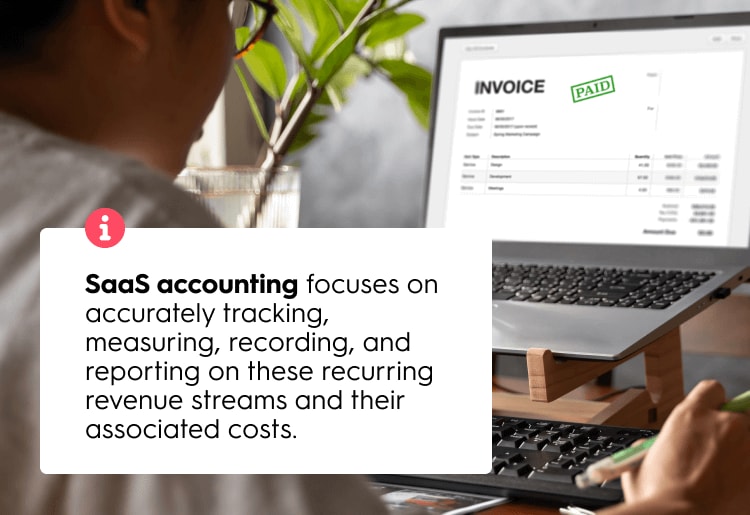It offers consistent revenue, predictable costs, and the ability to improve long-term customer retention.
However, the SaaS model presents accounting and financial challenges that are unique to subscription businesses. In this comprehensive guide, we’ll equip you with the fundamentals of SaaS accounting, its best practices, and actionable SaaS accounting strategies you can implement immediately.
What is SaaS Accounting?
SaaS accounting is similar to traditional accounting, but it’s tailored to the specific revenue and cost structures of subscription-based businesses. Unlike traditional product sales, which experience potentially significant variations in monthly, weekly, or even daily sales, SaaS companies generate consistent recurring revenue through monthly or annual subscriptions.
As a result, SaaS accounting focuses on accurately tracking, measuring, recording, and reporting on these recurring revenue streams and their associated costs.
Accounting software providers like Sage Accounting, provide business owners with valuable financial insights, enabling them to make informed business decisions.
How is SaaS Accounting Different?
SaaS accounting varies from traditional accounting in several key ways: revenue recognition, recurring vs. non-recurring costs, and subscription metrics. Let’s discuss these elements below:
Revenue Recognition: SaaS revenue is recognized in equal amounts throughout the subscription period, not all at once at the time of purchase. This is true whether the customer pays monthly or once every one or more years. This necessitates adherence to accounting standards such as ASC 606, which we’ll discuss later.
Recurring vs. Non-Recurring Costs: SaaS companies incur both recurring and non-recurring costs during the course of business. Recurring relates to recurring revenue, which must generally be recorded in the same period as the income they are related to.
Subscription Metrics: SaaS companies—and their accountants—rely heavily on subscription metrics like Customer Lifetime Value (CLV), Monthly Recurring Revenue (MRR), Customer Acquisition Cost (CAC), and Churn Rate to develop an understanding of financial health and potential future growth.
SaaS Accounting vs Traditional Accounting
While traditional accounting operates under many of the same rules and regulations as SaaS accounting, they differ in some areas. Let’s explore the key differences below:
SaaS Accounting
Traditional Accounting
Revenue Recognition
Recognized evenly throughout the subscription period under ASC 606
Recognized at the point of sale of goods or services
Expense Recognition
Expenses related to subscription revenue are recognized in the same period as their related income items
Recognized when the expense is incurred
Key Metrics
CLV, MRR, CAC, and churn rate
Income figures and cost of goods sold (COGS)
Cost Structure
Focuses on recurring costs such as server and warehouse upkeep, maintenance, and service delivery
Focuses on one-time production costs which can be tied directly to the products produced.
Types of SaaS Accounting
There are a range of accounting software options on the market, and many can effectively handle the unique accounting needs of SaaS companies. These options include:
Traditional Accounting Software with SaaS Features
This is when traditional accounting software, which can be utilized by many businesses, includes features geared toward SaaS companies. This is a popular choice as it’s generally affordable, offers core accounting functions like invoicing and expense tracking, and offers SaaS-specific features.
Wide range of features
SaaS features may not be extensive
User-friendly interfaces
SaaS businesses may find many features unnecessary
Allows remote access from your accountant
Software can be technical and may require education and training
Affordable software options
Extensive integrations with other business software
Specialized SaaS Accounting Software
Specialized SaaS accounting software is designed specifically for SaaS and subscription businesses. This software includes advanced features for revenue recognition under regulation ASC 606, expense recognition, subscription tracking, key metrics tracking, and complex reporting.
Wide variety of SaaS-focused features
Learning curve may be steeper than traditional accounting software
Scalable for SaaS businesses of nearly any sizer
Software costs may be higher
Includes the ability to track key SaaS metrics, such as CLV, MRR, CAC, and churn rate
Implementation can be complex
Customizable reports designed for SaaS business owners
Integrations with other business software may be limited
Common SaaS Metrics
Now that we understand what SaaS accounting software is, as well as the types of software available on the market, let’s explore common SaaS metrics and what they mean for your business:
Monthly Recurring Revenue (MRR): This metric represents the periodic revenue generated from subscription payments. This revenue can be received monthly or once every one or more years. A healthy MRR indicates consistent revenue and sustainable growth.
Customer Lifetime Value (CLV): This metric represents the total revenue a single customer is expected to generate over the lifetime of their relationship with your company. Understanding your CLV can help you optimize your customer acquisition budget and strategies.
Customer Acquisition Cost (CAC): This metric represents the cost of acquiring a new customer. It’s crucial to keep CAC below CLV for profitability, and the more you can reduce CAC, the better.
Annual Recurring Revenue (ARR): This metric represents the annualized version of MRR, providing a broader perspective of your company’s annual income.
Churn Rate: Churn rate is the percentage of your customers who cancel their subscriptions within a given period, such as per month, year, etc. A low churn rate indicates a healthy and loyal customer base.
Regulatory Compliance in SaaS
As with all things accounting, the government has implemented a complex series of regulations, several specific to SaaS businesses. Below is an overview of the key compliance frameworks SaaS companies need to be aware of:
ASC 606 (Revenue Recognition): ASC 606 is an accounting standard that dictates how SaaS companies must recognize revenue and related expenses over the subscription period rather than when the income is received or the expense incurred.
GDPR (General Data Protection Regulation): If your SaaS company handles customer data from residents of the European Union (EU), then you must comply with GDPR regulations related to data privacy and security, even if your business is not located in the EU.
SOC 2 (Service Organization Control 2): SOC 2 is a voluntary compliance framework that provides standards for data security, availability, processing integrity, confidentiality, and privacy. Obtaining a SOC 2 certification can build trust with customers and demonstrate your business’s commitment to data security.
Complying with these accounting and data standards is crucial. Companies and owners not adhering to these regulations may face significant penalties, legal trouble, or even jail time.

Best Practices for SaaS Accounting
SaaS accounting software can be helpful for SaaS businesses in several ways. Let’s explore some of the best practices for SaaS accounting below:
Streamline Financial Management
Accounting software allows businesses to automate accounting tasks, improve financial accuracy, and gain real-time insights into their financial performance. This allows businesses to make better financial and strategic decisions, improving operational efficiency. These benefits can be achieved simply by signing up for accounting software and integrating it into their business.
Automate Accounting Tasks
Most modern accounting software, such as Sage Accounting, offers extensive automation features, including generating financial reports, quotes and invoices, expense tracking, bank reconciliations, payroll and tax reports, and more. Automating these tasks can save businesses significant time and money. Since they’re built into the software, it’s as easy as clicking a few buttons.
Conduct Regular Audits and Account Reconciliations
Accounting software allows you to easily perform audits of your financial information and account reconciliations. These can alert you to any strategic or compliance issues and suggest solutions you can implement. The best practice is to utilize these features regularly, such as once per quarter, to ensure you stay on top of your business’s financial and regulatory health.
Use Financial Data for Growth Forecasting and Modeling
SaaS accounting software can generate comprehensive growth forecasts and financial models, giving you insight into your business’s potential future performance. These models can be customized to meet your needs and give you the most valuable insights possible. It’s important to create a variety of forecasts, such as a pessimistic outcome, a realistic one, and an optimistic one, and to generate these forecasts for various timelines, such as 1, 3, 5, and 10 years.
How to Choose the Right SaaS Accounting Software
Selecting the right accounting software is crucial for the success of any SaaS business. Consider the following key factors:
Scalability: Choose software that can grow with your business as you add more customers and complexity. For example, Sage Accounting offers various plans designed for SaaS businesses of any size, from small to large.
Integration: Ensure that your chosen accounting software can integrate seamlessly with the other tools you use. With a provider like Sage, you can integrate with CRMs, payment gateways, project management software, and more. This saves you time and money and lets you focus on running your business.
Features: Choose accounting software that offers the specific features your business needs, such as Sage’s advanced revenue recognition, subscription management, expense tracking, robust reporting capabilities, and more.
Bottom Line
SaaS accounting presents unique challenges and opportunities. By understanding the key principles, utilizing SaaS accounting software, and implementing best practices, businesses can effectively manage their finances, optimize profitability, and drive sustainable growth in the subscription economy.
To learn more and find the right accounting software for your SaaS business, take a look at Sage’s accounting software offerings.
